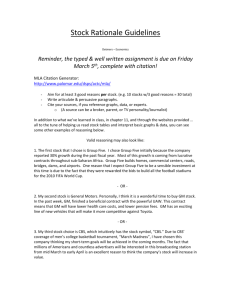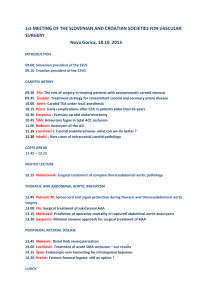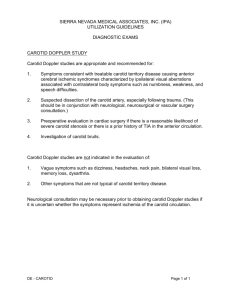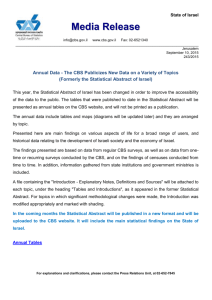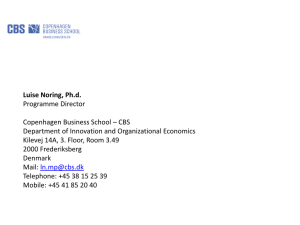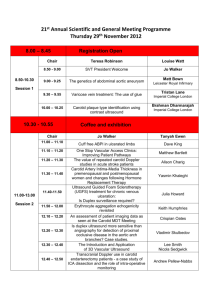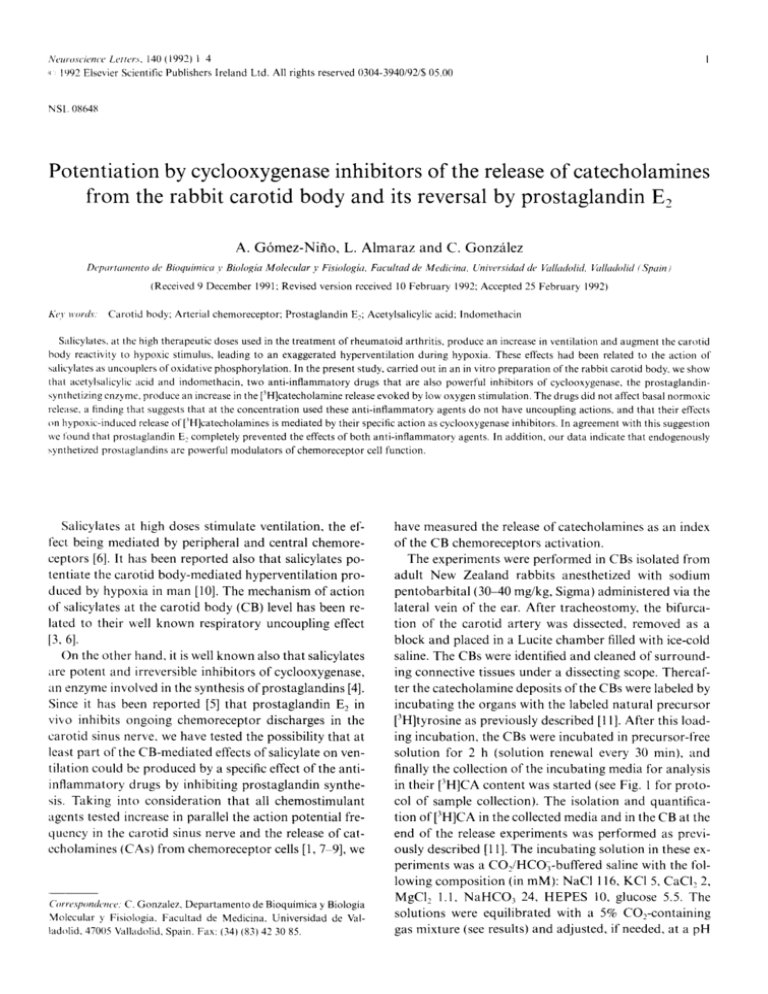
Neuroscience Lelter,*, 140 (1992) 1 4
,~: 1992 Elsevier Scientific Publishers Ireland Ltd. All rights reserved 0304-3940/92/$ 05.00
I
NSI, 08648
Potentiation by cyclooxygenase inhibitors of the release of catecholamines
from the rabbit carotid body and its reversal by prostaglandin E2
A. G6mez-Nifio, L. A l m a r a z and C. Gonzfilez
Depurtamento de Bioquhnica y Biologia Molecular y l~isiologia, Facultad de Medicina, Universi~kM de ValludolM, l idludolid (Spain)
(Received 9 December 1991: Revised version received 10 February 1992: Accepted 25 February 1992)
Key wor&v
Carotid body: Arterial chemoreceptor; Prostaglandin E.; Acetylsalicylic acid: lndomethacin
Salicylates, at the high therapeutic doses used in the treatment of rheumatoid arthritis, produce an increase in ventilation and augment the carotid
body reactivity to hypoxic stimulus, leading to an exaggerated hyperventilation during hypoxia. These effects had been related to the action of
salicylates as uncouplers of oxidative phosphorylation. In the present study, carried out in an in vitro preparation of the rabbit carotid body, we show
that acetylsalicylic acid and indomethacin, two anti-inflammatory drugs that are also powerful inhibitors of cyclooxygenase, the prostaglandinsynthetizing enzyme, produce an increase in the [3H]catecholamine release evoked by low oxygen stimulation. The drugs did not affect basal normoxic
release, a finding that suggests that at the concentration used these anti-inflammatory agents do not have uncoupling actions, and that their effects
on hypoxic-induced release of [3H]catecholamines is mediated by their specific action as cyclooxygenase inhibitors. In agreement with this suggestion
we found that prostaglandin E~ completely prevented the effects of both anti-inflammatory agents. In addition, our data indicate that endogenously
synt hetized prostaglandins are powerful modulators of chemoreceptor cell function.
Salicylates at high doses stimulate ventilation, the effect being mediated by peripheral and central chemoreceptors [6], It has been reported also that salicylates potentiate the carotid body-mediated hyperventilation produced by hypoxia in man [10]. The mechanism of action
of salicylates at the carotid body (CB) level has been related to their well known respiratory uncoupling effect
[3, 61.
On the other hand, it is well known also that salicylates
are potent and irreversible inhibitors of cyclooxygenase,
an enzyme involved in the synthesis of prostaglandins [4].
Since it has been reported [5] that prostaglandin E2 in
vivo inhibits ongoing chemoreceptor discharges in the
carotid sinus nerve, we have tested the possibility that at
least part of the CB-mediated effects of salicylate on ventilation could be produced by a specific effect of the antiinflammatory drugs by inhibiting prostaglandin synthesis. Taking into consideration that all chemostimulant
agents tested increase in parallel the action potential frequency in the carotid sinus nerve and the release of catecholamines (CAs) from chemoreceptor cells [1, 7 9], we
Correspondence. C. Gonzalez, Departamento de Bioquimica y Biologia
Molecular y Fisiologia, Facultad de Medicina, Universidad de Valladolid, 4701)5 Valladolid, Spain. Fax: (34) (83) 42 30 85.
have measured the release of catecholamines as an index
of the CB chemoreceptors activation.
The experiments were performed in CBs isolated from
adult New Zealand rabbits anesthetized with sodium
pentobarbital (30-40 mg/kg, Sigma) administered via the
lateral vein of the ear. After tracheostomy, the bifurcation of the carotid artery was dissected, removed as a
block and placed in a Lucite chamber filled with ice-cold
saline. The CBs were identified and cleaned of surrounding connective tissues under a dissecting scope. Thereafter the catecholamine deposits of the CBs were labeled by
incubating the organs with the labeled natural precursor
[3H]tyrosine as previously described [11]. After this loading incubation, the CBs were incubated in precursor-free
solution for 2 h (solution renewal every 30 min), and
finally the collection of the incubating media for analysis
in their [3H]CA content was started (see Fig. 1 for protocol of sample collection). The isolation and quantification of [3H]CA in the collected media and in the CB at the
end of the release experiments was performed as previously described [11]. The incubating solution in these experiments was a COjHCO3-buffered saline with the following composition (in mM): NaCI 116, KC1 5, CaCI, 2,
MgC12 1.1, NaHCO3 24, HEPES 10, glucose 5.5. The
solutions were equilibrated with a 5% CO2-containing
gas mixture (see results) and adjusted, if needed, at a pH
B
A
4000
T
•
o
3
4000
[] 20~ 0 2
4 -
-
ASA 100/~M
5% 02
ooot
3000
3
2000
(/3
1000
1000
o
0
O4
U3
2
2.5
2.0
6
1.5
o
x~
Control
o
0.5
g
l
3:
0.0
Control
Experimental
Control
Experimentel
Fig. l. Effects of acetylsalicylic acid on low oxygen-induced release of
[3H]CA in the rabbit CB. Single experiment. A shows the release of
[3H]CA from a CB (control) incubated with a 20% 02/5% CO2-equilibrated solution (empty bars), and subjected to two periods of 10 min of
hypoxic stimulation (incubation in a solution equilibrated with 5% 02/
5% CO> filled bars). B: another CB (experimental) was similarly incubated but the 10 min period prior to and during the second hypoxic
stimulation the incubating solutions contained 100/IM of acetylsalicylic acid (ASA). C shows the evoked release (cpm above the horizontal
lines throughout the bars), expressed as percent of [3H]CA tissue content, for both presentations of the stimulus ($1 and $2) and for control
and experimental CBs. D shows the ratios of the evoked release in the
second stimulus to that in the first stimulus ($2/S, ratios) for control and
experimental CBs.
of 7.40. Statistical significance of the differences observed was assessed by using a t-test for unpaired data.
Fig. 1 shows the release of [3H]CA from a pair of CBs
subjected to two consecutive hypoxic stimulations (incubation for 10 min in a 5% 02/5% CO2 rest N2-equilibrated solution; filled bars). In the experimental CB (Fig.
1B), the 10 min prior to and during the second presentation of the stimulus the solution contained 100 ~tM of
acetylsalicylic acid. It is evident that acetylsalicylic acid
potentiates low oxygen-induced release of [3H]CA. The
effect of the drug at this concentration on the basal
normoxic release (20% 02/5% CO2-equilibrated solutions) was somewhat variable. In some experiments we
observed a moderate increase in the basal release while in
others (like the one in the figure) there was not any significant effect. No effect on the basal release was observed
with lower concentrations of acetylsalicylic acid (20/IM),
Fig. 1C shows the stimulus-induced release (above horizontal lines in A and B) for control and experimental
CBs and for both presentations of the stimuli, S~ and S>
respectively, expressed as percent of endogenous [3H]CA
content. In Fig. 1D are represented the SJS~ ratios of the
[3H]CA-induced release for both CBs. This form of pre-
ASA
(100/zM)
Indo
(2/zM)
Fig. 2. Effects of acetylsalicylic acid and indomethacin on low oxygeninduced release of [3H]CA. The figure shows means _+ S,E.M. of the
$2/S~ ratios found in control, acetylsalicylic acid (ASA; 100 #M) and
indomethacin (Indo; 2 /IM)-incubated CBs. Protocols and hypoxic
stimulus intensity as in Fig. 1. *P < 0.005.
senting the data eliminates individual variations in the
absolute amounts of the evoked release and allows a better dissection of the effects of the drug. In this particular
experiment acetylsalicylic acid raised the SJS, ratio to
350% of that seen in the control CB, The rest of the
experiments to be presented were performed following
this protocol.
Fig. 2 shows mean $2/S, ratios obtained in 8 control
CBs, 4 CBs treated with 100 ~tM acetylsalicylic acid
and 8 CBs treated with 2 / I M indomethacin, another
anti-inflammatory agent and potent inhibitor of cyclooxygenase. It is evident that both agents increased markedly the release of [3H]CA induced by hypoxic stimulation (P< 0.005 in both cases). At this concentration indomethacin did not modify the basal normoxic release of
[3H]CA.
At the concentrations used, neither acetylsalicylic acid
nor indomethacin have effect as uncouplers of oxidative
phosphorylation [3], but they inhibit markedly cyclooxygenase, the prostaglandin-synthesizing enzyme [4].
Therefore we tested for the reversibility of the effects produced by both agents by the addition of prostaglandin
E 2. We chose this particular prostaglandin because it is
known that it inhibits the stimulus-induced release of CA
in different catecholaminergic structures and in different
species including the rabbit [12]. Table I shows that 300
nM of prostaglandin Ez applied simultaneously with indomethacin completely reversed the effect of the latter
agent. The same reversibility was observed for the acetylsalicylic acid effect (not shown). Prostaglandin E z, at
these concentrations, did not modify the basal release of
[3H]CA.
TABLE I
R E V E R S I B I L I T Y OF I N D O M E T H A C I N E F F E C T S BY P R O S T A G L A N D I N E,
Protocols for the experiments as in Fig. 1. Prostaglandin E e (PGE~) was added to the incubation solution of the experimental CBs at the same time
as indomethacin. Data are means _+ S.E.M. of 5, 6 and 4 values for control, indomethacin and indomethacin plus P E z, respectively.
Experimental
condition
S~
S,
SjS~
Control
lndomethacin (2 u M )
lndomethacin + PGE 2 (300 nM)
5.(10 + 0.45
4.80 + 0.52
5.28 + 0.36
4.17 + 0.46
10.42 +_ 1.71 *
1.34 + 0.39*
0.84 _+ 0.06
2.25 _+ 0.44*
0.24 _+ 0.06*
*P < 0.01 in all the cases.
The present results show that acetylsalicylic acid and
indomethacin potentiated low pO2-induced release of
[3H]CA without affecting the basal release. This effect is
completely reversed by simultaneous application of
prostaglandin E2, suggesting that the actions of these
anti-inflammatory drugs are not the result of their uncoupling properties, but produced via inhibition of cyclooxygenase with the subsequent decrease in endogenous prostaglandin production. Supporting this interpretation, we have found that average prostaglandin
E2 released to the incubating medium from 7 pairs of
CBs was 134.5 + 46.9 pmol/mg prot. in basal normoxic
conditions (20% O~/5% CO2), and 198.7 _+ 62.0 in hypoxic conditions (7% 02/5% CO2) (P<0.02). In two additional CBs incubated in the presence of indomethacin,
prostaglandin E, release was halved in normoxia and the
hypoxia-induced release was abolished.
These data show, for the first time, that prostaglandins
are modulators of chemoreceptor cell function and suggest that, at least in part, the inhibitory actions ofprostaglandin E, on carotid sinus nerve activity observed by
Belmonte and McQueen [5] were mediated via chemoreceptor cells and not solely mediated by changes in the CB
blood flow. It should be mentioned, however, that in the
same article these authors reported that, contrary to the
in vivo situation, in the vascularly isolated CB preparation when the spontaneous activity in the carotid sinus
nerve was low, prostaglandin E~ did not have any effect.
This latest finding is in agreement with the observation
on the lack ot" effect of prostaglandin E, on the basal
release in different preparations, including ours, in which
this prostaglandin inhibits the stimulus-induced release
[2, 121.
Regarding the mechanism of action of salicylates on
the production ofhyperventilation, it will appear that the
rapid hyperventilation observed immediately (within 1
min) after a high dose of the drug [6] could in fact be due
to an uncoupling effect, but the long lasting hyperreactivity to hypoxia [10] can be adequately explained on the
basis of our findings. Thus, an inhibition of prostaglandin synthesis will, on the arrival of a hypoxic stimulus, lead to an exaggerated release of catecholamines
(and probably of other neurotransmitters) and a concurrent exaggerated activity in the carotid sinus nerve and
ventilatory response.
The mechanism by which prostaglandin E 2 produces
its inhibitory effect remains to be established. Due to the
fact that it only affects the stimulus-induced release, and
that the effect can be at least partially abolished by increasing the extracellular concentration of Ca > [12], it is
tempting to suggest that prostaglandins interfere with
the stimulus-activated influx of Ca > into chemoreceptor
cells.
We want to thank M ~' de los Llanos Bravo for technical assistance. Work supported by Grants D G I C Y T
89/0358 and Junta de Castilla y Leon 1101/89.
1 Fidone, S., Gonz;ilez, C. and Yoshizaki, K., Effects of low oxygen
on the release of dopamine from the rabbit carotid body in vitro, J.
Physiol., 333 (1982) 93 110.
2 Hedqvist, P. and Persson, N.-A., Prostaglandin action on adrenergic and cholinergic responses in the rabbit and guinea pig intestine.
In O. Almgren, A. Carlsson and J. Engel {Eds.), Chemical Tools in
Catecholamine Research, Vol. II, North-Holland. Amsterdam,
1975, pp. 211-218.
3 lnsel, P.A.. Analgesic antipyretics and anti-inflammatory agents:
drugs employed in the treatment of rheumatoid arthritis and gout.
In A. G o o d m a n Gilman, T.W. Rail, A.S. Nies and P. Taylor (Eds.).
The Pharmacological Basis of Therapeutics, Pergamon, New York.
NY, 1990. pp. 638 681.
4 Kulmacz, R.J. and Lands, W.E.M., Cyclo-oxygenase: measurement, purification and properties. In C. Benedetto, R.G. McDonald-Gibson, S. Nigam and T.F. Slater (Eds.), Prostaglandins
and Related Substances, IRL Press, Oxford, 1987, pp. 209 227.
5 McQueen, D.S. and Belmonte, C., The effects of prostaglandins E 2,
A, and F2~ on carotid baroreceptors and chemoreceptors, Quart. J.
Exp. Physiol., 59 (1974) 63 71.
6 McQueen, D.S., Ritchie, I.M. and Birrell, G.J., Arterial chemoreceptors involvement in salicylate-induced hyperventilation in rats,
Br. J. Pharmacol., 98 i1989} 413 424.
7 0 b e s o , A., Almaraz, L, and Gonzalez, C., Effects of 2-deoxy-Dglucose on in vitro cat carotid body, Brain Res., 371 (1986) 25-36.
8 0 b e s o , A., Almaraz, L. and Gonzalez, C., Effects of cyanide and
uncouplers on chemoreceptor activity and ATP content of the cat
carotid body, Brain Res., 481 (1989) 250-257.
9 Rigual, R., L6pez-L6pez, J.R. and Gonzfilez, C., Release of dopamine and chemoreceptor discharge induced by tow pH and high
pCO: stimulation of the cat carotid body, J. Physiol., 433 (1991)
5t9 531.
10 Riley, D.J., Legawiec, B.A., Santiago, T.V. and Edelman, N.H.,
Ventilatory responses to hypercapnia and hypoxia during continuous aspirin ingestion, J. Appl. Physiol., 43 (t977) 971 976.
11 Rocher, A., Obeso, A., Herreros, B. and Gonz~ilez, C., Actiw~tion
of the release of dopamine in the carotid body by veratridinc. Ex.idence for the presence of voltage-dependent Na ~ channels in type 1
cells, Neurosci. Lett., 94 (1988) 274 -278.
12 Stj~irne, L., Role of prostaglandins and cyclic adenosine monophosphate in release. In D.M. Paton (Ed.), The Release of Catecholamines t'rom Adrenergic Neurons, Pergamon. Oxl'ord, pp. I I 1 142.



